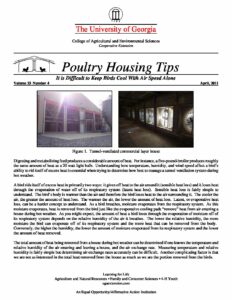Digesting and metabolizing feed produces a considerable amount of heat. For instance, a five-pound-broiler produces roughly the same amount of heat as a 20 watt light bulb. Understanding how temperature, humidity, and wind speed affect a bird’s ability to rid itself of excess heat is essential when trying to determine how best to manage a tunnel ventilation system during hot weather.
A bird rids itself of excess heat in primarily two ways: it gives off heat to the air around it (se...nsible heat loss) and it loses heat through the evaporation of water off of its respiratory system (latent heat loss). Sensible heat loss is fairly simple to understand. The bird’s body is warmer than the air and therefore the bird loses heat to the air surrounding it. The cooler the air, the greater the amount of heat loss. The warmer the air, the lower the amount of heat loss. Latent, or evaporative heat loss, can be a harder concept to understand. As a bird breathes, moisture evaporates from the respiratory system. As this moisture evaporates, heat is removed from the bird just like the evaporative cooling pads “remove” heat from air entering a house during hot weather. As you might expect, the amount of heat a bird loses through the evaporation of moisture off of its respiratory system depends on the relative humidity of the air it breathes. The lower the relative humidity, the more moisture the bird can evaporate off of its respiratory system and the more heat that can be removed from the body. Conversely, the higher the humidity, the lower the amount of moisture evaporated from its respiratory system and the lower the amount of heat removed.
The total amount of heat being removed from a house during hot weather can be determined if one knows the temperature and relative humidity of the air entering and leaving a house, and the air exchange rate. Measuring temperature and relative humidity is fairly simple but determining air exchange rates accurately can be difficult. Another complicating factor is that we are not as interested in the total heat removed from the house as much as we are the portion removed from the birds.
In August of 2010, a short study was conducted in a 150,000 bird commercial layer house to examine how air temperature affects the heat loss from birds in a tunnel house during hot weather. The study was conducted in this specific type of house for a number of reasons. First, it was a very basic tunnel house. All the fans were in one end wall, and all the tunnel openings were in the opposite end wall. This made the house air exchange rate extremely uniform from wall to wall and from floor to ceiling. Secondly, the house had no evaporative cooling system. This was important because without an evaporative cooling system, the heat loss from the birds at high ambient air temperatures could be determined which would have not been possible had evaporative cooling pads been in use. Last but not least, this type of commercial layer house has a very high density of birds per cubic foot of house volume compared to a typical broiler house. This meant the heat gained through the walls and ceilings was insignificant (less than 1%) relative to that produced by the birds.
Details
| Year | Volume | Number | Categories |
|---|---|---|---|
| 2011 | 23 | 4 |

